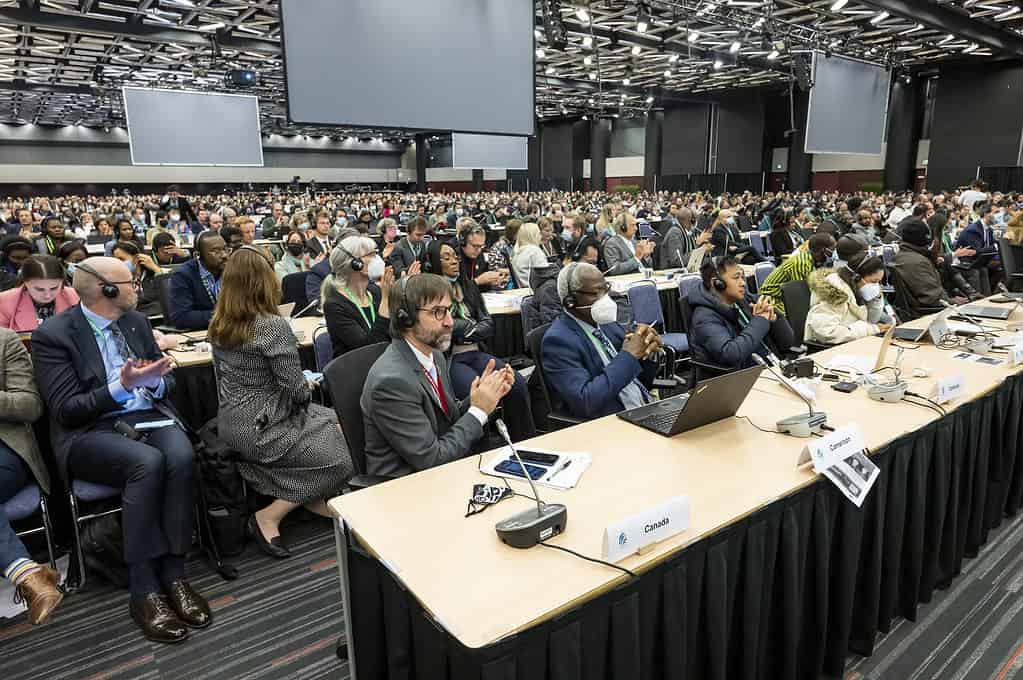Nearly 200 countries agreed to preserve 30% of the planet’s land and seas by 2030, among over 20 targets, as part of a new global framework on biodiversity, which is facing an existential threat. Governments and business leaders will have to take bold actions if they want to deliver on the agreement, following the failure of the previous biodiversity framework.

The deal, compared by campaigners to the Paris Agreement on climate change from 2015, comes as biodiversity is declining worldwide at rates never seen before in human history. A million plants and animal species are now at risk of extinction, with human activity being the main driver. We’re destroying wildlife by changing habitats on land and in the sea, as well as through climate change, resource exploitation, and pollution.
The Kunming-Montreal Global biodiversity framework (GBF), as it was called, was set after two weeks of tense negotiations in Montreal at the UN summit COP15. China chaired the conference, as it was supposed to host it there in 2020. However, after delays due to the Covid-19 pandemic, it was finally moved to Montreal, Canada.
Tensions ran high until the last minute before the agreement was implemented. The Democratic Republic of the Congo said it wasn’t willing to support it as not enough funding was guaranteed. However, moments later, China’s Environment Minister Huang Runqiu, said the agreement was done and rejected restarting the discussion.
“The agreement represents a major milestone for the conservation of our natural world, and biodiversity has never been so high on the political and business agenda, but it can be undermined by slow implementation and failure to mobilize the promised resources,” Marco Lambertini, head of the Worldwide Fund for Nature, said in a statement.
Ultimately, a deal was signed, though as the dust starts to settle, only some parts of the deal are truly clear.
The 30×30 target
The global biodiversity framework, or GBF, includes a list of 23 specific environmental targets for the world to deliver on by 2030, as well as four more broad goals for 2050. One of the most prominent would be securing 30% of land and oceans under protection, known as 30by30. Currently, 17% of the planet’s land and 8% of the oceans are officially protected.
The target specifically asks for the conservation of 30% of coastal and marine areas, instead of just mentioning the protection of at least 30% of land and ocean, as reflected in an earlier draft. This was seen as a win for ocean campaigners in the summit. The text also refers to tackling ocean acidification as a key driver of biodiversity loss.
The NGO Avaaz said 50% of land and ocean should have been protected in the agreement if parties wanted to reverse, and not simply halt, biodiversity loss. Adding up the existing protected areas and the Indigenous people’s territories where biodiversity is now protected would put the current global number already above 30%, the NGO said.
The idea was that by protecting a minimum of a third of the planet, we can ensure that at the very least, we don’t fall into a devastating mass extinction (which we’re already starting to see). It would be great to increase the goal to half of the planet, but even a third proved to be contentious and almost impossible to achieve.
Finance for biodiversity
As it so often happens, the main problem was money. Protecting nature costs money, and the money has to come from somewhere. But governments didn’t really agree on where.
The agreement calls to raise overall finance for biodiversity by US$200 billion by 2030, not just from government money but also from businesses and by redirecting harmful subsidies. Rich countries will also have to increase their funding to developing countries by at least US$20 billion per year by 2025 and then to US$30 billion every year by 2030.
This is much less than the US$100 billion a year that the Democratic Republic of the Congo was asking for, and the US$60 billion a year proposed by NGOs. Finance was by far the most tense topic in the two-week conference, with at one point developing countries deciding to temporarily walk out of the deliberations as a sign of protest.

A report by The Nature Conservancy, an NGO, estimated that at least $700 billion per year are needed to reverse global biodiversity loss by 2030. The new agreement doesn’t make any references to this funding goal being met every year by 2030, but it highlights that it should be “progressively” met to achieve a vision of living in harmony with nature.
“USD $20 billion a year until 2025, and then $30 billion a year until 2030, is a start, but it’s not enough. With a $700 billion biodiversity funding gap, it’s unclear where the rest of the money will come from. Finance is not only a question of how much, but how fast,” An Lambrechts, head of the Greenpeace delegation at COP15, said in a statement.
Indigenous rights
Indigenous communities largely celebrated the new biodiversity agreement as it recognizes their rights in strong language and on an unprecedented scale for a conservation plan. The text acknowledges the role of indigenous communities as “custodians of biodiversity” and says its implementation must ensure their rights, knowledge and values are respected.
Over the past four years since negotiations for the agreement started, indigenous communities’ representatives strongly campaigned for a rights-based approach. This means ensuring conservation isn’t in conflict with, but instead improves human rights. Jennifer Corpuz of the International Indigenous Form on Biodiversity said this is “historic.”
“It’s important for the rights of indigenous peoples to be there. And while it’s not the exact wording that we had proposed in the beginning, we feel that it is a good compromise and that it addresses the concerns that we have, and it provides us with enough basis to continue working in full partnership with the parties, with the countries,” Corpuz said.
At least a quarter of the global land area is owned, managed, used or occupied by indigenous people, according to the Intergovernmental Science-Policy Platform on Biodiversity and Ecosystem Services (IPBES). In a 2019 report, IPBES estimated that, of that area, about 70% can be classified as areas with very low human intervention.
Gender and health
There’s a strong link between human health and biodiversity and that’s also acknowledged in the agreement, which will have to be implemented with consideration of the One Health Approach from the World Health Organization (WHO). This is an initiative to balance and optimize the health of people, animals and the environment, preventing health threats.

As they implement the agreement, countries will have to ensure that the use, harvesting and trade of wild species is sustainable, safe and legal – preventing overexploitation and reducing the risk of pathogen spill-over. This was one of the possible reasons behind the Covid-19 pandemic, scientists have said, although it remains to be investigated.
There are also several mentions in the agreement of the role of women in protecting biodiversity. Achieving successful implementation will rely on ensuring general equality and empowerment of women and girls, the text reads, also calling for women’s participation in the decisions taken by countries as they start to take action on biodiversity.
Production and consumption
Food systems, a term that groups activities related to food production, transport, processing and consumption, are big drivers of biodiversity loss, land degradation and climate change. A UN report from earlier this year said food systems account for 80% of deforestation and 29% of greenhouse gas emissions globally – with similar figures seen in other reports.
The role of business in the production footprint is mentioned in the agreement, which seeks to “encourage and enable” companies to “regularly monitor, assess and transparently disclose their risks, dependencies and impacts on biodiversity”. It also asks companies to supply “information needed to consumers to promote sustainable consumption patterns.”
However, some environmental organizations said the requirements for companies in the agreement aren’t enough. Avaaz noted “with great concern” that the final text weakened the need for mandatory monitoring, assessment and disclosure of business impacts on biodiversity – something that was in previous versions of the text but was then taken out.
The role of consumption is also addressed in the agreement. One of the targets says governments have to encourage people to make sustainable consumption choices by adopting policy frameworks and improving education and access to information. There was also language related to diets in previous draft versions that was taken out of the final text.
Implementation of the agreement
The previous 10-year biodiversity agreement, the Aichi targets, failed to fully meet any of the 20 objectives to protect biodiversity at the global level, according to a UN report. But governments now argue they have learned their lesson, and the new agreement includes specific provisions for countries to make the targets measurable and track their progress.
Much of the text appears to copy the implementation scheme of the Paris Agreement on climate change – which asks countries to submit national climate plans (also known as NDCs) – specifies dates for stocktakes to take place and requires countries to increase their ambition after reviews. Whether this will happen or not still remains to be seen, NGOs said.
Countries will have to produce national biodiversity action plans “in alignment” with the new biodiversity agreement and its goals and targets. This should be done by COP16, the next biodiversity summit, scheduled for 2024 in Turkey. At COP16 and at the following summits, a global analysis of action plans should be done to assess the progress of the agreement.
“While Leo Messi and teammates now get to hang up their boots and luxuriate in a hard-fought victory – for the global biodiversity community, the next phase of hard work already beckons: mainstreaming the framework’s architecture into country-level policy that will deliver meaning progress,” said Andrew Deutz from The Nature Conservancy.






